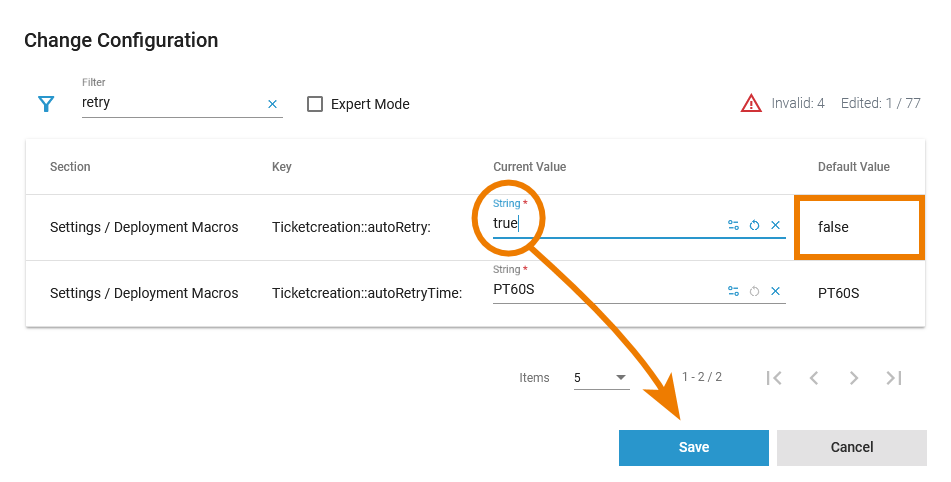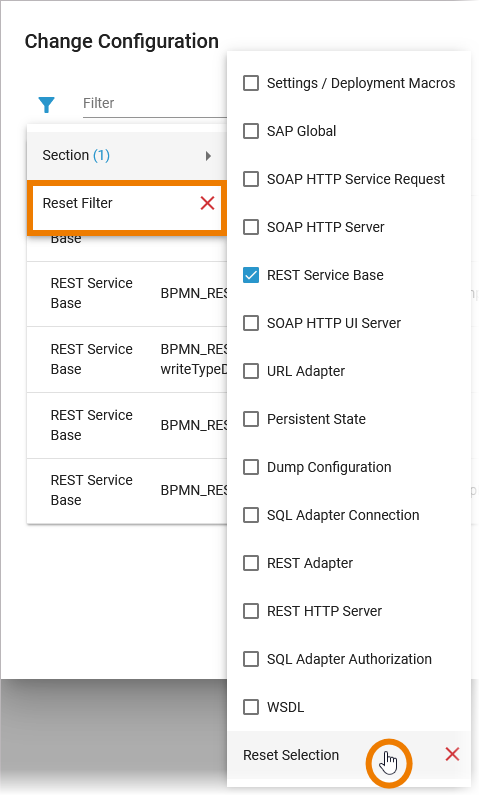- Created by Annegret Bernhardt, last modified on Mar 08, 2024
You are viewing an old version of this page. View the current version.
Compare with Current View Page History
« Previous Version 9 Next »
This option is only available for type xuml-service (= containerized xUML services).
The administration application allows you to change the configuration of a containerized xUML service.
| The administration application allows you to change the configuration of a Docker container. You have two options to open the configuration of a container: |
|
|
| In the Configuration section you can directly modify xUML service settings. When you save your changes, the container will be re-created and restarted. Changes are possible after the first deployment of the containerized service. |
| You can change the Current Value of a service setting. The Default Value is displayed next to the current value. Click Save after you have completed your changed. Please note:
|
| Service settings can be erroneous if a setting name contains special characters or whitespaces. Invalid service settings are marked If a service setting is erroneous, you cannot change its current value. In case that your service contains erroneous settings, you can do the following:
|
| As there are many available settings, use the filter field to search for the setting you want to modify. The content of the filter field is applied to the columns Section and Key. |
| Click Extended filter
If a filter is applied, the extended filter changes to |
| In the main filter window, you can reset all selected filters. Click In the filter option window, you can also reset the selection. |
xUML Service Settings
The settings are categorized into the following: You can modify settings of a service no matter if the service is running or if it has been stopped. Saving the changes triggers a re-create and restart of the container. Changing the settings on a stopped service will start the service. Settings will be stored, so if you stop the service and restart it, the settings are restored. If you delete a service, all settings are lost and cannot be recovered.
Global Settings
| Settings Group | Setting | Description | Allowed Values | |
|---|---|---|---|---|
| Settings / Deployment Macros | Service Composite | |||
| getCompositeCategory | Value returned by Action Language macro getCompositeCategory(). Initial value of this setting is the category specified in the service details (see Managing the Service Details). | any string | ||
| getCompositeName | Value returned by Action Language macro getCompositeName(). Initial value of this setting is the service name. | any string | ||
| getCompositeVersion | Value returned by Action Language macro getCompositeVersion(). Initial value of this setting is the service version in the service details (see Managing the Service Details). | a version string | ||
PAS Platform | ||||
| AuthenticatorEnabled | Specify whether users are allowed to identify themselves using an x-pas-user header instead of a bearer token. For compatibility reasons true (x-pas-header allowed) is the default option but this is deprecated and may lead to security issues. If you do not rely on the x-pas-header, we recommend setting this option to false. | true | Allow using an x-pas-header or a bearer token for authentication (default). | |
| false | Authentication only by bearer token. | |||
| AuthService::minimalAccessTokenLifeSpan | Define when a refresh token should be triggered. Default is 30 (if the token last less than 30 seconds it will be refreshed before it is used). In general there is no need to change the default of 30 seconds. | any integer | ||
| KeycloakInstance::clientId | Specify the clientId to use when authenticating the service. Default is keycloak-clientId. The clientId is defined in Keycloak, it should be changed in production to define specific authorization for this service. | any string | ||
| KeycloakInstance::clientSecret | Specify the clientSecret associated to the clientId. Default is keycloak-clientSecret. The clientSecret is defined in Keycloak, it should be changed in production to define specific authorization for this service. | any string | ||
| KeycloakAlias:Location:host | Specify the hostname (domain) of the Keycloak SSO system. Default is keycloak-host. | any string | ||
| KeycloakAlias:Location:basePath | Specify the subpath of the Keycloak system. Default is keycloak-basePath. | any string | ||
| KeycloakAlias:Location:port | Specify the port of the Keycloak system. Default cannot be changed. | 8080 | ||
| KeycloakAlias:Location:protocol | Specify the protocol of the Keycloak system. Default cannot be changed. | http | ||
| PasSecurityService::allowAnonymous | Specify whether anonymous users (no PAS users) should be allowed to send requests to the PAS BPMN service. In contrast to anonymous users, PAS users are identified by a bearer token or x-pas-user header). If this setting is set to false, requests of unauthenticated users will return HTTP error 401. This setting does not disable any role configuration within the BPMN. If there are lanes configured in the BPMN, the service can only be accessed by authenticated users. | true | Allow anonymous access (default). | |
| false | Access for identified users only. | |||
Service | ||||
| <service settings> | In your Designer service, you can define name-value pairs using the setting macro in an implementation. These values can be modified here. | |||
Add-on Settings
MultiExcerpt named xuml_service_add_on_settings was not found -- Please check the page name and MultiExcerpt name used in the MultiExcerpt-Include macro
Expert Mode
Use the checkbox Expert Mode to display further options:
| Option | Description |
|---|---|
| RAM | Use the slider to increase or decrease the RAM of a service. This option allows you to avoid that one service can comsume all resources. Default is 256 MB, the RAM maximum is 4 GB. You can change the RAM in steps of 64 MB. |
| Name | If you want to set xUML service settings for containerized services from the outside using the xuml-tool, you will need the Name (= friendly Id) as the environment variable. Refer to Integration Platform User's Guide > xUML Runtime Tool for details. |
- No labels











